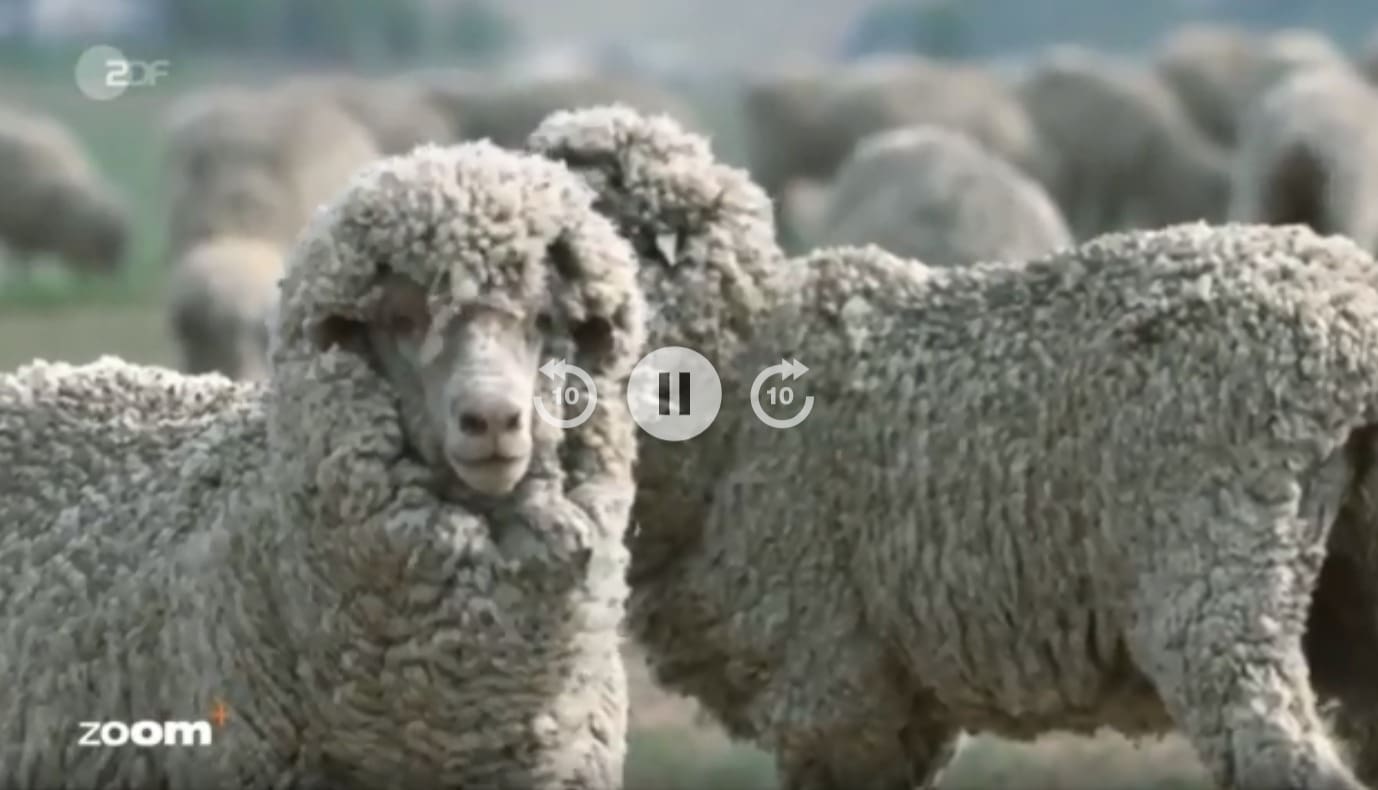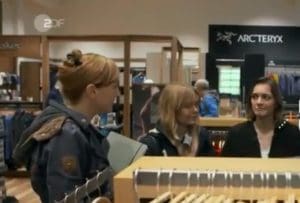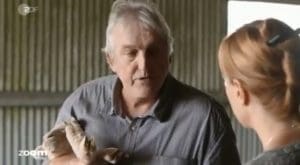 A NEED for greater transparency about Australian Merino wool production, marketing and sheep welfare trends – especially mulesing and pain relief — has been highlighted in a recent German television and newspaper investigation.
A NEED for greater transparency about Australian Merino wool production, marketing and sheep welfare trends – especially mulesing and pain relief — has been highlighted in a recent German television and newspaper investigation.
The SPIEGEL TV documentary for German station ZDF called ‘The true price of cuddly wool’, filmed last year and broadcast last month, interviewed international designers and retailers, and Australian growers, brokers and researchers about wool traceability, mulesing and animal welfare issues.
The TV documentary and an associated but independently written Der SPIEGEL magazine article have created concern among European processors and in Australia about the portrayal of wool welfare and sheep management practices.
The television and newspaper pieces have highlighted issues with the Australia’s anomalous mulesing and animal welfare statistics, industry transparency, exposing gaps in understanding within the German market on sheep welfare, mulesing and pain relief, and non-mulesing wool supply chains.
Germany is the 12 largest direct importer of raw Australian wool and is a major importer of woollen garments from China and other countries.
Sheep Central has been unable to obtain a full translation of the half hour SPIEGEL TV documentary; however, it has been viewed with concern by Merino wool processors and suppliers to European brands and retailers.
Sheep Central was told information given to the documentary makers about supply chain schemes linking wool consignments with pain relief and animal welfare practices was not included in the final footage.
Sheep Central has been unable to obtain a full translation of the half hour Spiegel TV documentary. SPIEGEL TV documentary researcher Joanna Michna supplied translations of her interview with Wal Merriman, of an interview with Sydney University researchers and of a short story accompanying the SPIEGEL TV documentary.

SPIEGEL TV researcher Joanna Michna interviews Merino garment consumers.
Ms Michna surveyed consumers in 34 well-known department stores and brands. When asked if they offered products made from mulesing-free wool, only eight companies responded that they either don’t run products with wool from Australia or want to make sure in the future that their wool is mulesing-free, she said. Ten trusted in their suppliers ‘ statements that no mulesing took place. However, no one can point to a transparent supply chain, the documentary claimed. This shows how difficult it is for consumers to find out about products, Ms Michna pointed out.
The TV footage also featured then Australian Wool Innovation chairman Wal Merriman walking out on a German documentary maker Joanna Michna, after maintaining that only increased price premiums — rather than grower appreciation of market concern about mulesing — would boost non-mulesed wool supply from Australia.
In the Der SPIEGEL article entitled ‘The screaming of the lambs – How sheep have to suffer for our cuddly merino sweaters,’ author Simone Salden claimed that 90 percent of Australian Merino sheep are mulesed “without anaesthesia”.
The newspaper article also quoted Four Paws anti-mulesing campaigner Hanna Zedlacher as saying “There is blood on this wool” and Stefan Dierks, sustainability manager for German retail chain Tchibo.
“We think it would be desirable for the Australian wool industry to follow a pathway from the mulesing process accepted by animal welfare organizations.
“The demand from our side is there anyway,” Mr Dierks said.
The TV and the newspaper article give the impression that most Australian sheep are mulesed without pain relief, claiming this was only recently adopted.
Click here to watch the SPIEGEL TV-ZDF documentary.
Click here to read the Der SPIEGEL article.
What the current mulesing and pain relief data says
The main mulesing pain relief chemical Tri-Solfen has been available in Australia for about 10 years and other products such as Boehringer Ingelheim’s injectable Metacam and the gel ILIUM® Buccalgesic OTM have been approved in the past two years. Although peak grower body WoolProducers Australia advocates using pain relief with mulesing, the Australian industry has failed to mandate the practice.
AWEX’s 2018 annual report states that the National Wool Declaration completion rate increased to 66pc for the 2017 season, up from 61pc in 2016, and 42.2pc in 2010.
National Council of Wool Selling Brokers of Australia executive director Chris Wilcox said the latest NWD statistics show that 12 percent of the wool offered at auction for the eight months of this season came from non-mulesed sheep and another 36pc is declared as from sheep mulesed with pain relief.
“Therefore that suggests that around about 45-50pc of sheep in Australia are either not mulesed or have been mulesed with pain relief.”
Ms Michna said she did not approach AWI to help her with the documentary, just Wal Merriman directly as a breeder and chairman of AWI. She also interviewed wool brokers, non-mulesed wool growers and former farm workers with parts of the industry being “extremely open and helpful”. She said the only politician the crew was able to interview was Animal Justice Party member Mark Pearson. The animal protection charity and anti-mulesing group Four Paws was “very helpful”.
Understanding of mulesing gained – Michna
Ms Michna said she had trouble understanding the different angles and interests of the industry, including “Mr Merriman’s background as a breeder and his interest to market strongly crimped wool to Italian buyers, to understand his course of action as AWI chairman”.
“One has to take into account the demand of the Chinese market and globalized supply chains to understand why the European demand for non-mulesed wool is not really putting pressure on Australian wool growers to enforce breeding programs… On the other hand the use of pesticides on non-mulesing farms is not discussed by animal right groups…”
Ms Michna said she learned that growing wool is a much more complex business than she ever thought.
“Land management, sheep welfare, genetic mixes, breeding programs, drought, flood issues and a super closed circle of a few holding the “power” in the business which creates quite a bit of fear and anxiety in the community of the others.”
Ms Michna said her goal was to provide an insight from different angles, showing what normally is not said about mulesing.
“That mulesing certainly looks cruel and bloody, but cannot be abandoned overnight for the risk of millions of sheep be killed by flystrike, that breeding programs exist, could certainly be conducted with more pressure, but they take time.
“That non-mulesing where it can be done means a great deal of more work (and in most instances the use of pesticides with its own problems) – all together that it is a very complex subject, which has certainly to be dealt with defining a long term goal: for example abandoning the practice and an short term goal, for example at least to use 100 percent pain management for the surgery on the sheep.”
Australian sheep “overbred” with wrinkles
In a short story accompanying the documentary, ‘Merino Boom – The true price of the softest wool’ Ms Michna described Merino wool as mostly coming from “completely overbred sheep in Australia”, “bred to have lots of skin wrinkles” pointing out that these wrinkles “can cost the sheep their lives”.
She also claimed that 90 percent of Merino in Australia undergo the painful procedure mulesing and “on the majority of farms without anaesthesia,” while stating that animal welfare organisations are sounding the alarm, secretly filmed material shocks consumers and Europe demands wool from sheep “that did not have to suffer like this.”
Ms Michna also claimed that “only ten percent of Australia wool is mulesing-free”, pointing out that giving up mulesing is labour-intensive and costly.
“In the long term, the wrinkles have to go. The majority of Australian farmers are reacting reluctantly as there is decades of breeding experience reflected in their flocks of sheep. In addition, the “genetic” solution is very lengthy. Sydney University veterinary practitioners, for example, have been breeding for eight years towards a less wrinkled sheep, whose wool is nevertheless showing the desired qualities. Meanwhile, the call for pain relief management during procedures and operations on the sheep is growing louder and louder.
“Yet, there is no binding legislation on this in Australia. The majority of farms still operate without anaesthesia.”
Ms Michna also quoted Hanna Zedlacher, from international animal protection charity Four Paws stating that “The chance of consumers finding a mulesing-free sweater in a normal store is still very slim at the moment.”
She pointed out that for customers in Germany, it is a particular challenge to find out which products were made from mulesing-free wool.
University of Sydney points out animal welfare reasons for mulesing

Professor Peter Windsor explaining mulesing to German documentary maker Joanna Michna.
Ms Michna also interviewed the University of Sydney’s Professor Peter Windsor who pointed out that mulesing is done for animal welfare reasons to stop fly infestation, which is the biggest killer of unmulesed at-risk sheep in Australia. Documentary commentary quoted a 2018 AWEX report that about 30 percent of farms use pain relief, although there is only a 66pc compliance with the National Wool Declaration. University of Sydney rural operations manager Stephen Burgun said after a year without mulesing, there were sheep getting struck with flies and that was also inhumane. It is estimated it would take another decade to breed the university flock to not require mulesing.
“We’ve been on our way for eight years and still have a lot of wrinkles.”
The commentary then states: The solution: Breeding programs and until then the use of pain management – but the reality is still a different one on many farms.”
New England Wool’s experience
New England Wool managing director Andrew Blanch was interviewed for the documentary. He did not wish to comment on the documentary as it is in German, he did not know all the sources used nor what kind of investigation was carried out.
However, he told Sheep Central he pointed out to the German TV crew that New England Wool has always been committed to environmental protection and fair treatment of animals and has promoted this within its highly valued and professional wool suppliers. He also pointed out that AWEX’s National Wool Declaration followed on from New England Wool’s early system involving a database of voluntary statements relating to wool declared as non-mulesed and ceased mulesed.
He said that since 2005, New England Wool has also supported Australian wool growers by giving a premium price for non-mulesed wool and in 2015 created the SustainaWOOL accreditation framework aimed at Australian growers. The fundamental philosophy is the promotion of the production of the best wool through sustainable management practices whilst respecting animal wellbeing and tracing the entire path of the wool. There are now more than 900 SustainaWOOL accredited farms that undergo periodic audits conducted by highly-qualified professionals who verify compliance to the established standards of the scheme (e.g. Wool quality, animal welfare and health, chemical use and storage, environment, traceability and social responsibility).
Mr Blanch said consumers around the world are becoming more and more sensitive to environmental topics and animal welfare.
“Thus, the importance of the SustainaWOOL Integrity Scheme and its growth to more than 900 accredited farms.
“As an example of the global reach of this sensitivity, one of our shareholders, Successori Reda, has been working hard to raise awareness in wool producers, clients and the fashion system in general, and orienting them towards a 360° approach to sustainability.”
Understanding of mulesing gained – Michna
Ms Michna said her goal was to provide an insight from different angles, showing what normally is not said about mulesing.
“That mulesing certainly looks cruel and bloody, but cannot be abandoned overnight for the risk of millions of sheep be killed by flystrike, that breeding programs exist, could certainly be conducted with more pressure, but they take time.
“That non-mulesing where it can be done means a great deal of more work (and in most instances the use of pesticides with its own problems) – all together that it is a very complex subject, which has certainly to be dealt with defining a long term goal: for example abandoning the practice and an short term goal, for example at least to use 100 percent pain management for the surgery on the sheep.”
Time to make mulesing pain relief mandatory – Windsor
Professor Windsor told Sheep Central this week that he had quoted the estimation that more than 100 million lambs had been treated with Tri-Solfen since it was registered. He spoke to the German researchers after they had seen cases of flystrike in a Tasmanian flock that had ceased mulesing. He told Ms Michna it was now common practice to use pain relief when mulesing sheep and that the University of Sydney, despite introducing low-wrinkle rams, felt mulesing with pain relief achieved a better welfare outcome “and we had no flystrike to show her.”
“We need to get some better data on pain relief and mulesing
“Anecdotally, certainly in our area, everybody is using it, but we’ve had resistance from some people,” he said.
“I think we are at the stage, where we should say if you are going to mules, you have to use pain relief – I think we need to make it mandatory, because mulesing without it is abysmal, it’s horrific and it’s unacceptable.
“We just have to move the industry to accept that …, so if you are going to persist in fine wool production and you are going to have to mules for better welfare then you need to use pain relief.”

We ceased mulesing 12 years ago. For 30 years we have been culling any ewe lamb that is urine-stained in the lamb marking cradle. The incidence of this is now very low; less than 1 percent. The more we objectively select our ewes for more wool, the plainer they get. Wool growers should stop telling their ewes what to look like and start telling them what to do. It is not hard, and the big plain ewes have more lambs too. We have been shearing at eight months for five years and still crutching. We are now about to start shearing at six months with no crutching. Mulesing only reduces wrinkle score by 1.5-2 points, whereas breeding can knock off three scores in a generation, with no cost to wool cut. With blowfly resistance to all major chemical groups, all wool growers will have to look at alternatives.
Really, what do we do with Wally, or perhaps more importantly, what do we do with AWI? As I have often said, Wally is just symptomatic of the problem. Failure for AWI to get on the front foot with animal welfare and mulesing is such a disaster that the whole board should be sacked at the next shareholder meeting; on this and this alone never mind the multitude of other issues.
Last year I hosted a Swiss German researcher, who had contacted AWI three times with no reply. This woman was researching how small and medium sized manufacturing companies responded to customer needs to know the provenance of the product they were purchasing.
After taking this researcher, who prior to her trip to Australia had thoroughly researched the mulesing issue to a number of properties in the Western District of Victoria and the Riverina of NSW, she finally exploded in exasperation at Australia’s failure to tell the world the wonderful story of the Australian Merino!
In Europe, with their system of industrialised animal production where the young are taken from their mother at a few days old, or perhaps never know their mother, to see the Merino, nurturing its young until 14 or 15 weeks, lying happily under red gum trees with plenty of food and water, compared with what the Europeans know of animal welfare…. well, there was no comparison. Why aren’t you telling the world, she said. My answer wasn’t suitable for repeating publicly.
When can we agree that the tsunami of disdain towards mulesing will flood over the wool industry and damage it for decades? Surely everyone can see that more and more people all over the world are voicing their concerns about the practice. Let’s set a date soon, to phase it out. Not only will it be good for us wool producers, and the buyers and users of wool, but the sheep will love it too.